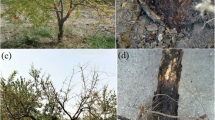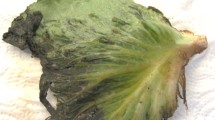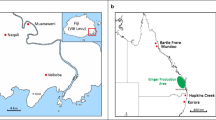Abstract
In Australia, Pythium soft rot (PSR) outbreaks caused by P. myriotylum were reported in 2009 and since then this disease has remained as a major concern for the ginger industry. From 2012 to 2015, a number of Pythium spp. were isolated from ginger rhizomes and soil from farms affected by PSR disease and assessed for their pathogenicity on ginger. In this study, 11 distinct Pythium spp. were recovered from ginger farms in Queensland, Australia and species identification and confirmation were based on morphology, growth rate and ITS sequences. These Pythium spp. when tested showed different levels of aggressiveness on excised ginger rhizome. P. aphanidemartum, P. deliense, P. myriotylum, P. splendens, P. spinosum and P. ultimum were the most pathogenic when assessed in vitro on an array of plant species. However, P. myriotylum was the only pathogen, which was capable of inducing PSR symptoms on ginger at a temperature range from 20 to 35 °C. Whereas, P. aphanidermatum only attacked and induced PSR on ginger at 30 to 35 °C in pot trials. This is the first report of P. aphanidermatum inducing PSR of ginger in Australia at high temperatures. Only P. oligandrum and P. perplexum, which had been recovered only from soils and not plant tissue, appeared non-pathogenic in all assays.




Similar content being viewed by others
References
Bahramisharif A, Lamprecht SC, Spies CFJ, Botha WJ, Calitz FJ, McLeod A (2013) Pythium spp. associated with rooibos seedlings, and their pathogenicity toward rooibos, lupin, and oat. Plant Dis 98:223–232
Butler EJ (1907) An account of the genus Pythium and some Chytridiaceae. Memoirs of the Department of Agriculture, India (Botanical Series) 1:70
Camacho HE, Brescia A (2009) The Australian ginger industry: overview of market trends and oppotunities. Department of Employment, Economic Development and Innovation, The State of Queensland, p. 54
Chellemi DO, Mitchell DJ, Kannwischer-Mitchell ME, Rayside PA, Rosskopf EN (2000) Pythium spp. associated with bell pepper production in Florida. Plant Dis 84:1271–1274
Dhingra OD, Sinclair JB (1995) Basic plant pathology methods, 2nd edn. CRC Press, United States of America
Dick MW (1990) Keys to Pythium. The College of Estate Management. Whiteknights, Reading, Great Britain
Dohroo NP (2001) Etiology and management of storage rot of ginger in Himachal Pradesh. Indian Phytopathol 54:49–54
Dohroo NP (2005) Diseases of ginger. In: Ravindran PN, Babu KN (eds) Ginger, the genus Zingiber. CRC Press, Boca Raton, pp. 305–340
Doyle JJ, Doyle JL (1990) Isolation of plant DNA from fresh tissue. Focus 12:13
Gerbore J, Benhamou N, Vallance J, Le Floch G, Grizard D, Regnault-Roger C, Rey P (2014) Biological control of plant pathogens: advantages and limitations seen through the case study of Pythium oligandrum. Environ Sci Poll Res 21:4847–4860
Hogarth J (2000) Buderim ginger: an export success story : a history of the ginger industry of Queensland. Hogarth & Buderim Ginger Ltd, Yandina, Qld
Kavitha PG, Thomas G (2008) Expression analysis of defense-related genes in Zingiber (Zingiberaceae) species with different levels of compatibility to the soft rot pathogen Pythium aphanidermatum. Plant Cell Rep 27:1767–1776
Kim CH, Yang SS, Park KS (1997) Pathogencity and mycological characteristics of Pythium myriotylum causing rhizome rot of ginger. Korean J Plant Pathol 13(3):152–157
Kroon LPNM, Bakker FT, van den Bosch GBM, Bonants PJM, Flier WG (2004) Phylogenetic analysis of Phytophthora species based on mitochondrial and nuclear DNA sequences. Fungal Genet Biol 41:766–782
Kumar A, Reeja ST, Bhai RS, Shiva KN (2008) Distribution of Pythium myriotylum Drechsler causing soft rot of ginger. JOSAC 17(1):5–10
Le PD, Smith MK, Aitken EAB (2010) Pythium spp. on ginger (Zingiber officinale Roscoe) in Australia. In: Sterling GR (ed) 6th ASDS Proceedings, Twin Waters, Queensland, p. 62
Le DP, Smith M, Hudler GW, Aitken E (2014) Pythium soft rot of ginger: detection and identification of the causal pathogens, and their control. Crop Prot 65:153–167
Le DP, Smith MK, Aitken EAB (2015) Pythiogeton ramosum, a new pathogen of soft rot disease of ginger (Zingiber officinale) at high temperatures in Australia. Crop Prot 77:9–17
Levesque CA, De Cock AWAM (2004) Molecular phylogeny and taxonomy of the genus Pythium. Mycol Res 108:1363–1383
Li Y, Mao LG, Yan DD, Liu XM, Ma TT, Shen J, Liu PF, Li Z, Wang QX, Ouyang CB, Guo MX, Cao AC (2014a) First report in China of soft rot of ginger caused by Pythium aphanidermatum. Plant Dis 98:1011
Li YP, You MP, Barbetti MJ (2014b) Species of Pythium associated with seedling root and hypocotyl disease on common bean (Phaseolus vulgaris) in Western Australia. Plant Dis 98:1241–1247
Lumsden RD, Ayers WA, Dow RL (1975) Differential isolation of Pythium species from soil by means of selective media, temperature and pH. Can J Microbiol 21:606–612
Martin FN (2000) Phylogenetic relationships among some Pythium species inferred from sequence analysis of the mitochondrially encoded cytochrome oxidase II gene. Mycologia 92:711–727
McLeod A, Botha WJ, Meitz JC, Spies CFJ, Tewoldemedhin YT, Mostert L (2009) Morphological and phylogenetic analyses of Pythium species in South Africa. Mycol Res 113:933–951
Mu JH, Bollon AP, Sidhu RS (1999) Analysis of β-tubulin cDNAs from taxol-resistant Pestalotiopsis microspora and taxol-sensitive Pythium ultimum and comparison of the taxol-binding properties of their products. Mol Gen Genet 262:857–868
Perneel M, Tambong JT, Adiobo A, Floren C, Saborío F, Lévesque A, Höfte M (2006) Intraspecific variability of Pythium myriotylum isolated from cocoyam and other host crops. Mycol Res 110:583–593
van der Plaats-Niterink AJ (1981) Monograph of the genus Pythium. Studies of Mycology 21:1–244
Robideau GP, Gachon CMM, Hu C-H, Küpper FC, Rintoul TL, Sarhan E, Verstappen ECP, Zhang Y, Bonants PJM, Ristaino JB, Lévesque CA, De Cock AWAM, Coffey MD, Voglmayr H, Brouwer H, Bala K, Chitty DW, Désaulniers N, Eggertson QA (2011) DNA barcoding of oomycetes with cytochrome c oxidase subunit I and internal transcribed spacer. Mol Ecol Resour 11:1002–1011
Stanghellini ME, Kronland WC (1985) Bioassay for quantification of Pythium aphanidermatum in soil. Phytopathology 75:1242–1245
Stirling GR, Turaganivalu U, Stirling AM, Lomavatu MF, Smith MK (2009) Rhizome rot of ginger (Zingiber officinale) caused by Pythium myriotylum in Fiji and Australia. Australas Plant Pathol 38:453–460
Teakle DS (1962) Investigation on the genus Pythium in Queensland. The University of Queensland, Master theis of Agricultural Science
Tsai YP (1991) List of plant disease in Taiwan. The plant protection society of the republic of China and the Phytopathological society of the republic of China. Taichung, Taiwan
Wang PH, Chang CW (2003) Detection of the low-germination-rate resting oospores of Pythium myriotylum from soil by PCR. Lett Appl Microbiol 36:157–161
White TJ, Bruns T, Lee S, Taylor J (1990) Amplification and Direct Sequencing of Fungal Ribosomal RNA Genes for Phylogenetics. In: Innis MA, Gelfand DH, Sninsky JJ, White TJ (eds) PCR Protocols: a Guide to Methods and Applications. Academic Press, Inc., California, pp. 315–322
Zhang BQ, Yang XB (2000) Pathogenicity of Pythium populations from corn-soybean rotation fields. Plant Dis 84:94–99
Zitnick-Anderson KK, Nelson BD (2014) Identification and pathogenicity of Pythium on soybean in North Dakota. Plant Dis 99:31–38
Yuan JD, Zhang YL, Qi JS, Zhang B, Xu ZT, Li L, Li CS (2013) Pathogen identification of ginger stalk rot from Shandong province. Acta Phytopath Sin 43:S525
Acknowledgments
This work is a part of ‘Pythium spp. on ginger in Australia’ project funded by Rural Industries Research and Development Corporation (PRJ-008410) in conjunction with the Australian Ginger Growers Association. We greatly thank Mr. Rob Abbas from Rob Abbas Consulting Pty. Ltd. for sampling diseased ginger; Dr. David Teakle (retired) for critical reading the manuscript. The first author also wants to thank Australian Endeavour Awards for rewarding a PhD scholarship.
Author information
Authors and Affiliations
Corresponding author
Rights and permissions
About this article
Cite this article
Le, D.P., Smith, M.K. & Aitken, E.A.B. An assessment of Pythium spp. associated with soft rot disease of ginger (Zingiber officinale) in Queensland, Australia. Australasian Plant Pathol. 45, 377–387 (2016). https://doi.org/10.1007/s13313-016-0424-5
Received:
Accepted:
Published:
Issue Date:
DOI: https://doi.org/10.1007/s13313-016-0424-5




